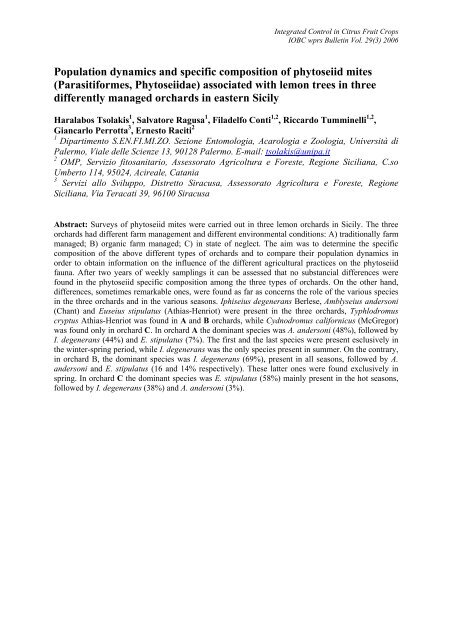Integrated Control in Citrus Fruit Crops - IOBC-WPRS
Integrated Control in Citrus Fruit Crops - IOBC-WPRS
Integrated Control in Citrus Fruit Crops - IOBC-WPRS
Create successful ePaper yourself
Turn your PDF publications into a flip-book with our unique Google optimized e-Paper software.
<strong>Integrated</strong> <strong>Control</strong> <strong>in</strong> <strong>Citrus</strong> <strong>Fruit</strong> <strong>Crops</strong><br />
<strong>IOBC</strong> wprs Bullet<strong>in</strong> Vol. 29(3) 2006<br />
Population dynamics and specific composition of phytoseiid mites<br />
(Parasitiformes, Phytoseiidae) associated with lemon trees <strong>in</strong> three<br />
differently managed orchards <strong>in</strong> eastern Sicily<br />
Haralabos Tsolakis 1 , Salvatore Ragusa 1 , Filadelfo Conti 1,2 , Riccardo Tumm<strong>in</strong>elli 1,2 ,<br />
Giancarlo Perrotta 3 , Ernesto Raciti 2<br />
1<br />
Dipartimento S.EN.FI.MI.ZO. Sezione Entomologia, Acarologia e Zoologia, Università di<br />
Palermo, Viale delle Scienze 13, 90128 Palermo. E-mail: tsolakis@unipa.it<br />
2<br />
OMP, Servizio fitosanitario, Assessorato Agricoltura e Foreste, Regione Siciliana, C.so<br />
Umberto 114, 95024, Acireale, Catania<br />
3 Servizi allo Sviluppo, Distretto Siracusa, Assessorato Agricoltura e Foreste, Regione<br />
Siciliana, Via Teracati 39, 96100 Siracusa<br />
Abstract: Surveys of phytoseiid mites were carried out <strong>in</strong> three lemon orchards <strong>in</strong> Sicily. The three<br />
orchards had different farm management and different environmental conditions: A) traditionally farm<br />
managed; B) organic farm managed; C) <strong>in</strong> state of neglect. The aim was to determ<strong>in</strong>e the specific<br />
composition of the above different types of orchards and to compare their population dynamics <strong>in</strong><br />
order to obta<strong>in</strong> <strong>in</strong>formation on the <strong>in</strong>fluence of the different agricultural practices on the phytoseiid<br />
fauna. After two years of weekly sampl<strong>in</strong>gs it can be assessed that no substancial differences were<br />
found <strong>in</strong> the phytoseiid specific composition among the three types of orchards. On the other hand,<br />
differences, sometimes remarkable ones, were found as far as concerns the role of the various species<br />
<strong>in</strong> the three orchards and <strong>in</strong> the various seasons. Iphiseius degenerans Berlese, Amblyseius andersoni<br />
(Chant) and Euseius stipulatus (Athias-Henriot) were present <strong>in</strong> the three orchards, Typhlodromus<br />
cryptus Athias-Henriot was found <strong>in</strong> A and B orchards, while Cydnodromus californicus (McGregor)<br />
was found only <strong>in</strong> orchard C. In orchard A the dom<strong>in</strong>ant species was A. andersoni (48%), followed by<br />
I. degenerans (44%) and E. stipulatus (7%). The first and the last species were present esclusively <strong>in</strong><br />
the w<strong>in</strong>ter-spr<strong>in</strong>g period, while I. degenerans was the only species present <strong>in</strong> summer. On the contrary,<br />
<strong>in</strong> orchard B, the dom<strong>in</strong>ant species was I. degenerans (69%), present <strong>in</strong> all seasons, followed by A.<br />
andersoni and E. stipulatus (16 and 14% respectively). These latter ones were found exclusively <strong>in</strong><br />
spr<strong>in</strong>g. In orchard C the dom<strong>in</strong>ant species was E. stipulatus (58%) ma<strong>in</strong>ly present <strong>in</strong> the hot seasons,<br />
followed by I. degenerans (38%) and A. andersoni (3%).

















